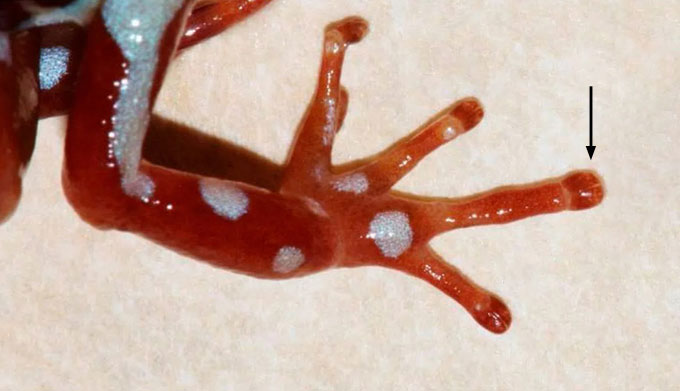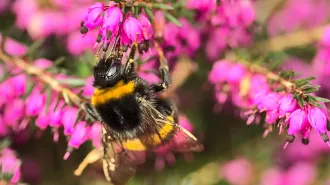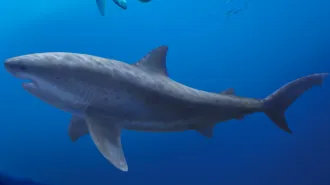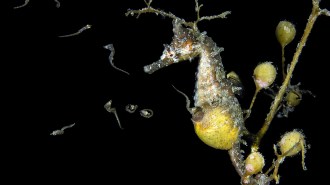Pheromone fingers may help poison frogs mate
Some males stick their seductive digits near a female's nose

A mating pair of Anthony's poison arrow frogs (Epipedobates anthonyi) demonstrate cephalic amplexus. The male (left) is holding the female (right) by her head, with his swollen finger closest to her nostrils. Researchers think this positioning may help the male transfer pheromones to the female.
Diana Abondano Almeida
During mating, some male poison frogs embrace their partner’s face in a love-potion-laced hug.
The amorous amphibians may create pheromones in glands in their fingers, researchers report July 21 in Molecular Ecology, highlighting an evolving understanding of the complexity of frog mating.
Field biologist Diana Abondano Almeida and her colleagues were studying chemical communication in amphibians and noticed a combination of quirks in male poison frogs. The males of some species have one markedly swollen fingertip on each hand that becomes even more bulbous during the reproductive season. Mating in frogs often includes “amplexus,” which often is where the male grips onto the female from behind, sometimes for hours or days (SN: 6/14/16). In cephalic amplexus, an unusual variant unique to most poison frogs, the males grasp the females by the face, with the fingers resting near their mate’s mouth and nostrils.
This placement — especially with the concurrence of swollen fingers in some species — seemed too specific to be “mere coincidence,” says Almeida, of Goethe University in Frankfurt. Other amphibians, such as salamanders, are known to use chemicals called sodefrin precursor-like factors, or SPFs, during courtship. Some salamanders produce these SPFs using skin glands and transfer them to their mate through close contact. Almeida and her team wondered if the frogs’ fingers were producing similar pheromones used in mating.

The researchers took tissue samples from the fingers of the males of two species of poison frogs: stripe-throated rocket frogs (Leucostethus brachistriatus) from Colombia and a lab-reared population of Anthony’s poison arrow frog (Epipedobates anthonyi). Using genetic analysis, they compared the relative numbers of RNA transcripts — copies of the DNA sequence used to make proteins, including pheromones — in swollen and normal fingers. In both frog species, dozens of SPF genes were churning out hundreds to thousands of times more RNA in the swollen fingers.
Almeida and her colleagues think the males are channeling these finger pharmaceuticals into the females’ nostrils or skin through the prolonged direct contact. Given that amplexus occurs well after the frogs have paired up, the pheromones probably aren’t used for attraction, Almeida says. Rather, they may kick off physiological changes in the female. “[They] could induce the female to deposit eggs, or at least accelerate this process.”
Historically, frog courtship has been studied mostly with a focus on sound, particularly their repertoire of croaks and creaks, says Sarah Woodley, an integrative physiologist at Duquesne University in Pittsburgh. But in recent years, researchers have started recognizing the role of the visual, tactile and chemical components of frog mating (SN: 6/2/14; SN: 2/2/23).
“They’re sophisticated animals,” Woodley says. “They are not just using one sensory modality to communicate. It’s not all about calling.”
Almeida says there are plenty of next steps in this research. While the giant upswing in SPF transcripts certainly hints at the fingertips being specialized pheromone factories, future studies could find and isolate these proteins and determine if and how they influence the female frogs’ biology.







